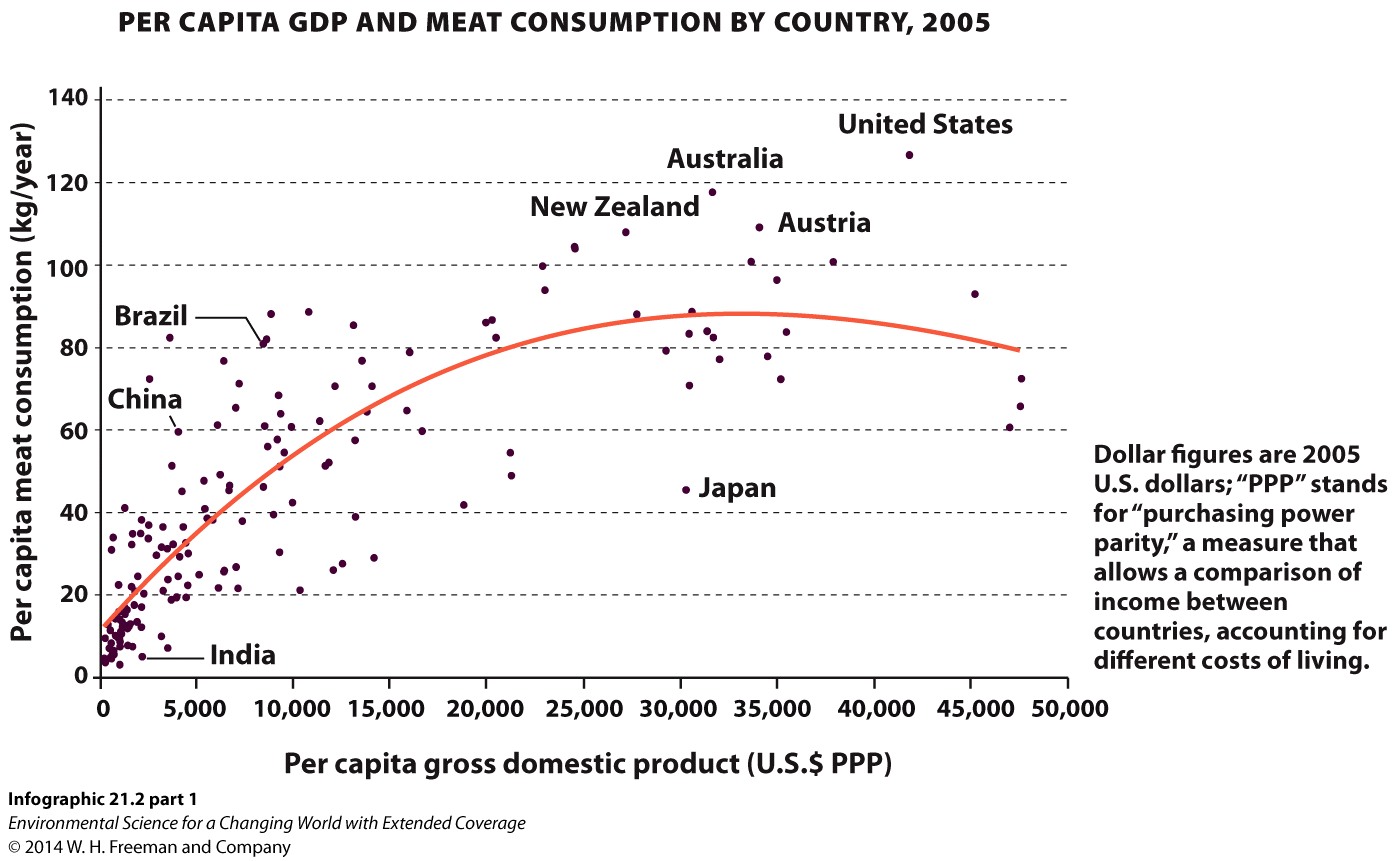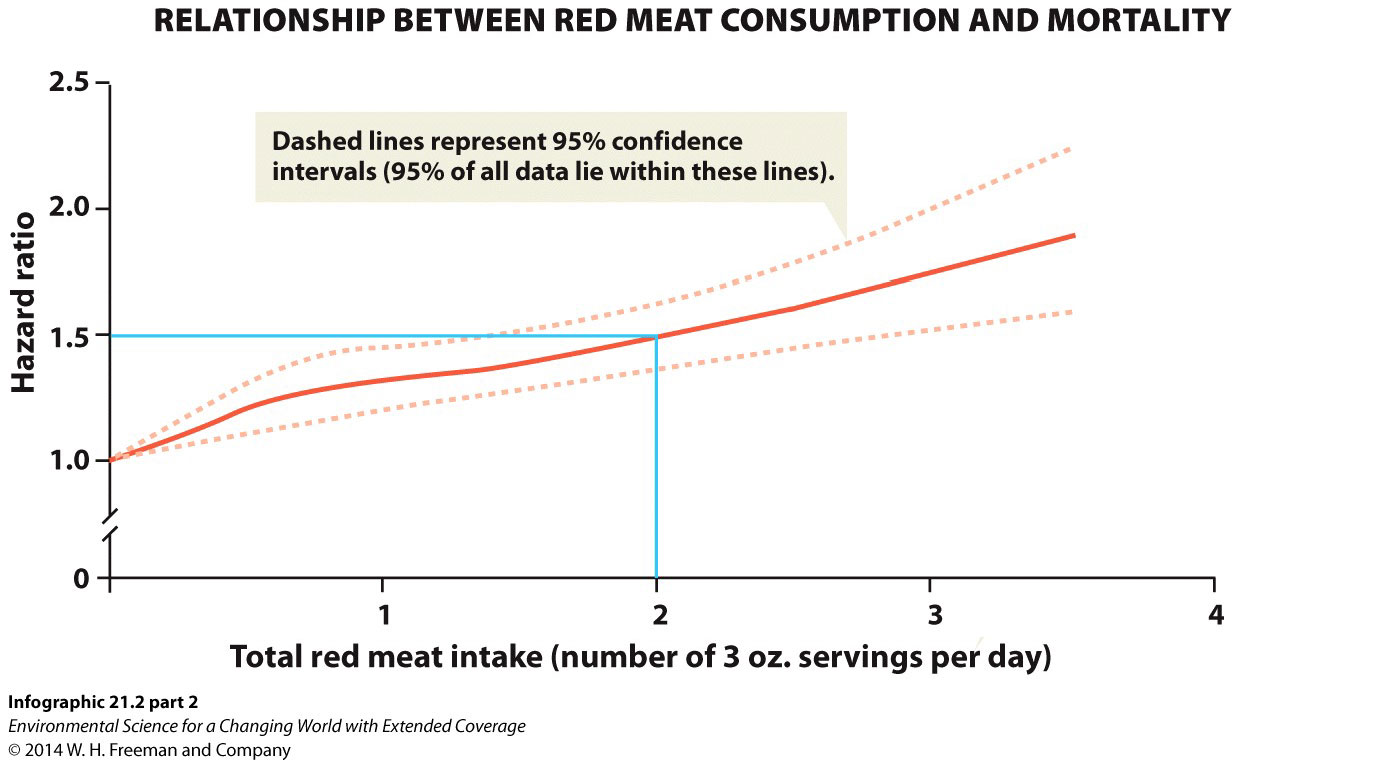Chapter 21. Chapter 21: Agriculture: Raising Livestock
How does affluence affect diet and health?

Guiding Question 21.2
How does affluence affect diet and health?
Why You Should Care
Some social scientists use the term “Affluenza” (a pun on affluence and influenza) to describe a disease of developed, and sometimes developing, countries caused by placing too large a priority on the attainment of physical wealth and comforts. People consumed with living the “good life” can ironically become less healthy and happy. A common side effect of affluenza is obesity, along with the many diseases associated with it. As recently as the Great Depression, it was common, even among the middle class, for families to eat meat only a few times a week. Even if meat was eaten daily, it was in much smaller portions. The reason for the difference between then and now is that people then had to pay the true price of the meat they ate. They either raised it themselves or bought meat whose cost wasn't offset by government subsidies. Meat soon became cheaper, and consumers, possibly seeing meat as a sign of success, began to eat more and more of it. With this change in diet came an increase in obesity and other diseases that had once been rare. The world's two most populous countries, India and China, are now going through a similar dietary transition, as their citizens' incomes and standards of living increase. Time will tell if these countries will be able to avert the health crisis and environmental issues that were experienced by the United States.

Question 21.1
2ohInOPUq1tzPQhM9uRwZT2phghvSQDnG1SvYnh/BUXOOnk/Dwe1Cy4ZBwLLGNnouy3FwlGOrAkfGg2sjPTWz/bUUrWxofgsxf6CNzMcAqDMv3uOdCgwHRz68wPa5yOXkWNpKcVW+SH+TjVY99xoRb6745yEdgqZxw9NdCAPZqlPYR+oyec1qdWtaXBlqiMJiWKLu7Hek1qW52MP9iZxeUOZ35HlgFM3L1MoOV6sqxpCEKoyH8nw/jiE1lfOD1ZwEI3perzL1Jo8feH7GLbLTTTb7TMRvKdGHX0KA77a85d4vPqEf4rhpxSx4YhSvpnq725F0Q0ILYfGq4zuEY3ufVvoEGo7/j7pm+0ltNUjgY5fprLcWiubY99rjrY=Question 21.2
03GANvlET0yrhZ8+8f72ic9ukwhGHQANDU19Naqz6immHhXgkTyxGi+cyskCK1iLaxeLK0taRD/PukCJ3+u4mtiuZVitpG58yaKId+Elbr+ui6u2B0LZuQ3LtnK2Ef/BmMQi5ew6hGJ4DPZruQ/pDLH3hKprZheQiH5SeFBhGBYzUo6ksFIwY2DxQdH1nHwJgZCob/0+rx1B3ztLWbNUDtpY+SUx+wPmk+vkomsElW2uYg/Lr6yua5TTjR6wF5QYMrw5Ok77fGHz70tgUXoZC/b5Z7EatFnfgXC2717QebuCfZ/us0HdELZHyMoGvKlB34W1C0hnzKjim7rQuyz6jldc7c9claOoPWs9Epng1R+WU1dgm07XEquVy/QKFiEBrVXs21jEjdbtJ9UxDDNs3VEu4qf57cYYchogaklLcihytrt5bcrMXRfcUCaqeCXZOfQImMVI/i8=Question 21.3
du5/u8VmA6IwmCSU6ZXDl5UUPVeLvq2A4uZT+VLNk5RxbISFiVlCz6Yak5G/+DjibGgv8iSyAXDqY80EmHWuVDrfyab8rDXps2zxE6GcYTqot/37S8Q1jSUy8KSdJYNq2HAh7VgT8eCNFF7nItXKB37WJH4tA1npSzkQ12FE/9sLbQFABRNxsyAaV9cLI2+NkNWCMGoCn/hHEXk/FjzhuhvmZ90u5B7JT42tYA==Question 21.4
HelNKBDAiLufJflUUzu9WdwR2JO1XT9Hm7IDyhhfqM6XgfcmwMb+uFl4oNpl3+tyzLJ7gkVlHMoewDQqa+DQrGCOR8QKbaxwlMCQFNDlCgIbncVRv747qf1mzwwb6W0yQuestion 21.5
/6K0LCqCJ7BfBxEjMR9dPXzmhnJWgAKZ91Kezn0mo7w7vvMaB+AKXdJvp7rfPQSsSVd2eXzfytc/n4mU2nVPUVZhfLI4zNXjUZb1FPjjs2ia9TNoO3da58wq8NqBNskdPlsJ/FTSHs1LhUtyIPg7v3wyGuObBInPjKSyjq3KS3t7UVxA3JljRelYOF9ZnlocfjnbtHpseIaUDz/3eNm6VKMPffi00k/f3zLtB+xHBhKKOLZrm+MuK7M8cPAVp2Dq+qRn+gh8MzDQUCrpuUD5csSWkeznossx4nFSOThAZ/MQutepQ8bQfTVquGL3nixlPJuHlQM4m9VMzsePfUJ1+LY0Mv2Xvr5AhtrKZDn+7OY00qVV0/bO9iaUuM39YkCFqIyJmvcutqlFPvQQqTKzqqX/pAlOoNHIEGmWWquadONHVPgGKq9jKHbKkL/PS13WbhRVj5llYDccRbEtpKAFWf8uG3AXr9+yIcdiH8kxGv3jbv6NbRQ4K69J5VlTqj6tF5soDttDKMoNVcoE676qcbU/q4hOkr4/rejpqkNdY019GmODu2MsKXXq2LTwlR76dDbnH0LYzhuewOQcF7HHy7O48ZV6TIZiXCDz2kW6pyjZ/KXkGJo3ZT8IE4pFYGFJIndia: 3 kg/$3,650 = 0.0008 kg/$
China: 54 kg/ $8,442 = 0.006 kg/$
United States: 125 kg/$48,442 = 0.002 kg/$
So, it would seem that the average person in China spends more of his or her income on meat consumption than either the United States or India. India consumes meat per income at a rate an order of magnitude lower than either the United States or China. You could propose any of a number of reasons for the difference between India and China. One would be cultural: Vegetarianism is part of many of the faiths in India, but not in China. Another would be that perhaps there is a minimum level of income at which buying meat regularly becomes feasible.
